
The Hygrophoraceae are a family of fungi in the order Agaricales. Originally conceived as containing white-spored, thick-gilled agarics, including Hygrophorus and Hygrocybe species, DNA evidence has extended the limits of the family, so it now contains not only agarics, but also basidiolichens and corticioid fungi. Species are thus diverse and are variously ectomycorrhizal, lichenized, associated with mosses, or saprotrophic. The family contains 25 genera and over 600 species. None is of any great economic importance, though fruit bodies of some Hygrocybe and Hygrophorus species are considered edible and may be collected for sale in local markets.

Hygrophorus is a genus of agarics in the family Hygrophoraceae. Called "woodwaxes" in the UK or "waxy caps" in North America, basidiocarps are typically fleshy, often with slimy caps and lamellae that are broadly attached to decurrent. All species are ground-dwelling and ectomycorrhizal and are typically found in woodland. Around 100 species are recognized worldwide. Fruit bodies of several species are considered edible and are sometimes offered for sale in local markets.

The Tricholomataceae are a large family of mushrooms within the Agaricales. Originally a classic "wastebasket taxon", the family included any white-, yellow-, or pink-spored genera in the Agaricales not already classified as belonging to e.g. the Amanitaceae, Lepiotaceae, Hygrophoraceae, Pluteaceae, or Entolomataceae.

Cuphophyllus is a genus of agaric fungi in the family Hygrophoraceae. Cuphophyllus species belong to a group known as waxcaps in English, sometimes also waxy caps in North America or waxgills in New Zealand. In Europe, Cuphophyllus species are typical of waxcap grasslands, a declining habitat due to changing agricultural practices. As a result, four species, Cuphophyllus atlanticus, C. colemannianus, C. lacmus, and C. lepidopus are of global conservation concern and are listed as "vulnerable" on the IUCN Red List of Threatened Species.
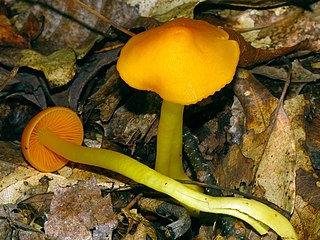
Humidicutis is a small genus of brightly coloured agarics, the majority of which are found in Eastern Australia. They were previously described as members of Hygrocybe. The genus Porpolomopsis is closely related, and the species in it were once placed in Humidicutis. The genus was described by mycologist Rolf Singer in 1959.

Lichenomphalia is both a basidiolichen and an agaric genus. Most of the species have inconspicuous lichenized thalli that consist of scattered, small, loose, nearly microscopic green balls or foliose small flakes containing single-celled green algae in the genus Coccomyxa, all interconnected by a loose network of hyphae. The agaric fruit bodies themselves are nonlichenized and resemble other types of omphalinoid mushrooms. These agarics lack clamp connections and do not form hymenial cystidia. The basidiospores are hyaline, smooth, thin-walled, and nonamyloid. Most of the species were originally classified in the genera Omphalina or Gerronema. Historically the species were classified with those other genera in the family, the Tricholomataceae together with the nonlichenized species. Lichenomphalia species can be grouped into brightly colored taxa, with vivid yellow and orange colors, versus the grey brown group, depending upon the microscopic pigmentation deposits. Molecular research comparing DNA sequences now place Lichenomphalia close to the redefined genus Arrhenia, which together with several other genera not traditionally considered to be related, fall within the newly redefined Hygrophoraceae.

Arrhenia is a genus of fungi in the family Hygrophoraceae. Arrhenia also includes species formerly placed in the genera Leptoglossum and Phaeotellus and the lectotype species itself has an unusual growth form that would not normally be called agaricoid. All of the species grow in association with photosynthetic cryptogams such as mosses, including peat moss, and alga scums on decaying wood, and soil crusts consisting of mixes of such organisms. Typically the fruitbodies of Arrhenia species are grey to black or blackish brown, being pigmented by incrusting melanized pigments on the hyphae.
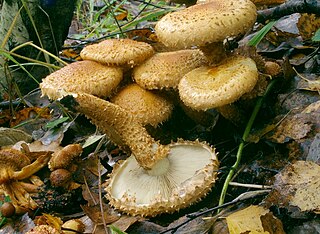
Pholiota is a genus of small to medium-sized, fleshy mushrooms in the family Strophariaceae. They are saprobes that typically live on wood. The genus has a widespread distribution, especially in temperate regions, and contains about 150 species.

The Mycenaceae are a family of fungi in the order Agaricales. According to the Dictionary of the Fungi, the family contains 10 genera and 705 species. This is one of several families that were separated from the Tricholomataceae as a result of phylogenetic analyses. Taxa in the Mycenaceae are saprobic, have a cosmopolitan distribution, and are found in almost all ecological zones. The family was circumscribed by Caspar van Overeem in 1926.
Haasiella is a fungal genus in the family Hygrophoraceae. It is a monotypic genus that contains only the species Haasiella splendidissima. Haasiella venustissima, formerly considered to be a distinct species based on its one and two-spored basidia, was found by a DNA study to be synonymous with H. splendidissima. H. splendidissima is only known from Europe and is saprotrophic on wood. Haasiella was described as a new genus in 1966 by Czech mycologists František Kotlaba and Zdeněk Pouzar. It is most closely related to the genus Hygrophorus.

Pseudoarmillariella is a genus of fungi in the family Hygrophoraceae. The genus contains three species found in Central America, North America, and Asia. Pseudoarmillariella was described by mycologist Rolf Singer in 1956.
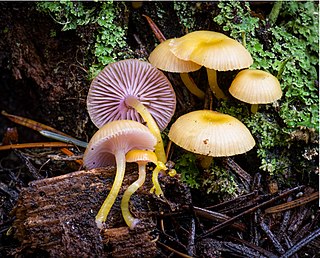
Chromosera is a genus of fungi in the family Hygrophoraceae. Within the family Hygrophoraceae it is closely related to the genus Gloioxanthomyces. It contains five species. The generic name honors the mycologist Meinhard Moser, and also alludes (chromos) to the distinct coloration of the mushrooms, by overlapping 'chromos' with 'Moser', hence Chromosera.
Dictyonema is a genus of mainly tropical basidiolichens in the family Hygrophoraceae.

Gliophorus is a genus of agaric fungi in the family Hygrophoraceae. Gliophorus species belong to a group known as waxcaps in English, sometimes also waxy caps in North America or waxgills in New Zealand. In Europe, Gliophorus species are typical of waxcap grasslands, a declining habitat due to changing agricultural practices. As a result, two species, Gliophorus europerplexus and Gliophorus reginae, are of global conservation concern and are listed as "vulnerable" on the IUCN Red List of Threatened Species.

Muscinupta is a fungal genus that produces small white delicate fan-shaped to cupulate fruitbodies on mosses. It is monotypic, containing the single species Muscinupta laevis. The type species is better known under the name Cyphellostereum laeve but Cyphellostereum is a basidiolichen.

Aphroditeola is an agaric fungal monotypic genus that produces pink cantharelloid fruit bodies on coniferous forest floors. The lamellae are forked and typically the fruit bodies have a fragrant odor described as candy-like, cinnamon-like or pink bubble gum-like.

Saproamanita nauseosa is a species of agaric fungus in the family Amanitaceae. First described by English mycologist Elsie Maud Wakefield in 1918 as a species of Lepiota, it was named for its nauseating odor. The type specimen was found growing on soil in the Nepenthes greenhouse at Kew Gardens. Derek Reid transferred the species to Amanita in 1966, and then in 2016 the separate genus Saproamanita was created by Redhead et al. for saprophytic Amanitas and it was transferred to this new genus.
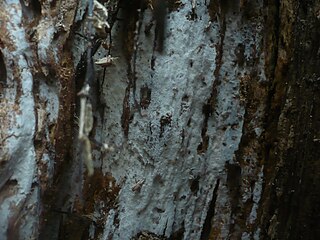
Eonema is a fungal genus in the family Hygrophoraceae. It is monotypic, consisting of the single corticioid species Eonema pyriforme. This fungus was previously classified in the genus Athelia until molecular analysis demonstrated that it was unrelated to the Atheliales and instead nested within the Hygrophoraceae.
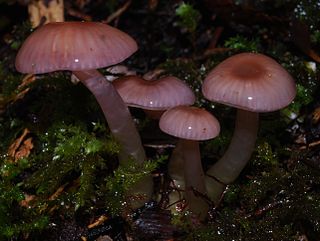
Gliophorus versicolor is a species of agaric fungus in the family Hygrophoraceae. Found in New Zealand, it was described as new to science in 1973 by mycologist Egon Horak. Within the genus Gliophorus, it is classified in the section Glutinosae, a grouping of species characterized by having bright colors, decurrent gills, and a gelatinized subhymenium. Fruit bodies have hemispherical to convex caps typically measuring 20 mm (0.8 in), although some have been recorded up to 50 mm (2.0 in). Moist caps are gluey with a color ranging from reddish brown to pinkish-lilac; the cap margin has radial grooves mirroring the gills underneath. The gills have an adnate to somewhat decurrent attachment to the stipe. They are widely spaced with color similar to the cap, or whitish. The cylindrical, hollow stipe measures 2–7 cm (0.8–2.8 in) by 1.5–3 mm (0.06–0.12 in) thick. The fungus is saprobic, and fruits on the ground among Dacrycarpus and Nothofagus.

Arrhenia chlorocyanea, commonly known as the verdigris navel, is a species of agaric fungus in the family Hygrophoraceae. Originally named as a species of Agaricus in 1885, and later classified as a member of Omphalina, the species was transferred to the genus Arrhenia in 2002. It is found in Europe and North America.
















